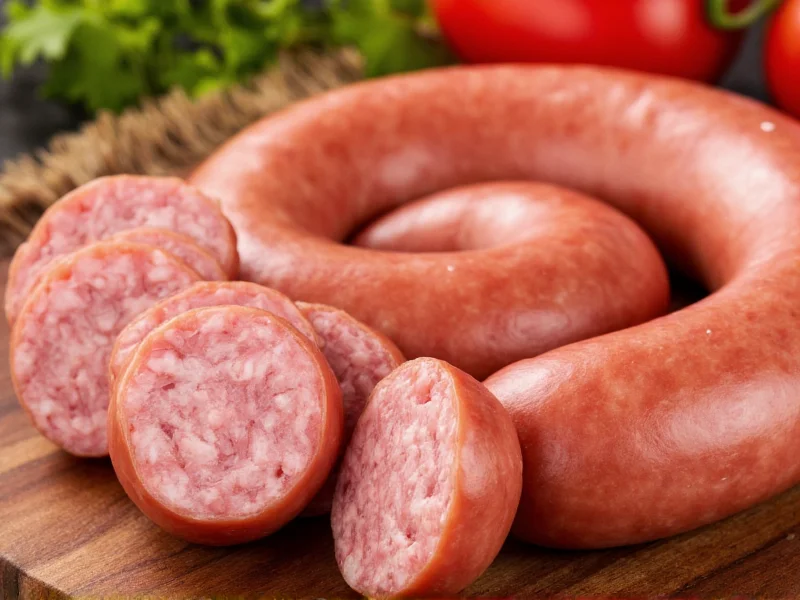Understanding sausage calories is essential for anyone monitoring their dietary intake. Whether you're tracking macros, managing weight, or simply making informed food choices, knowing the precise calorie content helps you maintain control over your nutrition.
Factors That Affect Sausage Calorie Count
Sausage isn't a one-size-fits-all food when it comes to calories. Several key factors influence the final calorie count:
- Meat composition: Higher fat content means more calories (fat contains 9 calories per gram vs protein's 4 calories)
- Sausage size: Links can range from small breakfast portions (1.5 oz) to large dinner sausages (4+ oz)
- Additives: Fillers, breadcrumbs, and seasonings contribute additional calories
- Cooking method: Grilling versus frying affects fat retention and final calorie count
Calorie Comparison of Common Sausage Types
| Sausage Type | Typical Serving Size | Calories | Fat Content |
|---|---|---|---|
| Standard Pork Breakfast Sausage | 2 links (1.7 oz/48g) | 140-180 | 12-15g |
| Turkey Breakfast Sausage | 2 links (1.7 oz/48g) | 90-120 | 5-7g |
| Italian Sausage (Pork) | 1 link (3.5 oz/99g) | 250-300 | 20-25g |
| Chicken Sausage | 1 link (3.5 oz/99g) | 180-220 | 12-15g |
| Bratwurst | 1 link (3.3 oz/94g) | 280-320 | 24-28g |
| Veggie Sausage | 1 link (3 oz/85g) | 70-110 | 2-5g |
How Cooking Method Changes Calorie Content
The way you prepare your sausage significantly impacts its final calorie count. Many people don't realize that cooking method can alter the nutritional profile:
- Grilling: Allows fat to drip away, potentially reducing calories by 10-15% compared to raw
- Pan-frying: Sausages absorb some cooking oil, adding approximately 20-40 extra calories
- Baking: A middle ground option that preserves most nutrients while allowing some fat drainage
- Boiling: Removes the most fat but can affect texture and flavor
Research from the USDA FoodData Central shows that a grilled pork sausage typically contains about 15% less fat than the same sausage pan-fried in oil. This translates to roughly 20-30 fewer calories per standard link.
Nutritional Context: Where Sausages Fit in Your Diet
When considering how many calories is in a sausage, it's helpful to understand how this fits within daily nutritional needs. For an average adult on a 2,000-calorie diet:
- A single standard sausage represents 7-15% of daily calorie needs
- The same sausage often provides 20-25% of recommended daily saturated fat
- Most sausages deliver 10-15 grams of protein per serving
Nutritionists generally recommend treating traditional pork sausages as occasional indulgences rather than daily staples due to their high saturated fat content. If you enjoy sausages regularly, consider rotating between standard pork varieties and leaner options like chicken or turkey sausage to balance your fat intake.
Reading Sausage Nutrition Labels Effectively
When determining calories in a standard pork sausage from packaging, pay attention to:
- Serving size: Many packages list 1 link as a serving, but some count 2-3 links
- "Per 100g" information: This allows for easier comparison between brands
- Fat breakdown: Look for sausages with less than 20g fat per 100g for healthier options
- Additives: Watch for hidden sugars and sodium content
The most accurate way to track sausage calories per 100g is to weigh your cooked sausage and calculate based on the raw nutritional information, as cooking changes the weight through moisture and fat loss.
Healthier Sausage Alternatives
If you're monitoring your calorie intake but still want sausage flavor, consider these alternatives:
- Lean meat sausages: Chicken, turkey, or lean pork varieties typically have 30-40% fewer calories
- Veggie sausages: Plant-based options often contain half the calories of traditional sausages
- Homemade sausages: Control ingredients and fat content precisely
- Portion control: Enjoy one regular sausage with plenty of vegetables rather than multiple links
Registered dietitians often recommend pairing sausages with high-fiber vegetables to create a more balanced meal that keeps you satisfied longer while reducing the overall calorie density of your plate.











 浙公网安备
33010002000092号
浙公网安备
33010002000092号 浙B2-20120091-4
浙B2-20120091-4